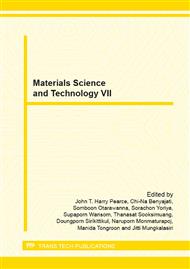p.31
p.36
p.47
p.52
p.57
p.63
p.69
p.77
p.82
Modifying Poly(L-Lactic Acid) Matrix Film Properties with High Loaded Poly(Ethylene Glycol)
Abstract:
Poly(L-lactic acid) (PLA) is a biodegradable and bioabsorbable polymer which has many potential uses. However, PLA shows the poor toughness, slow degradation rate and relatively hydrophobic.Poly(ethylene glycol) (PEG) is widely used as a plasticizer and of great interest because it presents outstanding properties, e.g. solubility in water and also in some organic solvents, lack of toxicity and absence of antigenicity and immunogenicity, which are essential for biomedical applications. The aim of this study was to investigate the ability of high amount PEG 400 to improve the characteristics of PLA matrix film. PLA matrix films were prepared using a solvent casting method and their various properties were investigated. Mechanical properties were determined with texture analyzer. Contact angle and surface free energy were measured using the goniometer. From the mechanical properties evaluated (tensile strength (TS) and elongation at break (E)), all plasticized PLA films exhibited the softer behavior and the plasticized PLA films with150 % PEG 400 indicated the higher % elongation at break than pure PLA, significantly. The contact angle and surface free energy values indicated that PEG 400 could improve the wettability of solventsand also increase % water sorption and % weight loss with as dose dependent.Surprisingly, SEM photographs revealed more porous structure as the higher amount PEG 400 was incorporated in PLA film. This porous structure and density of developed plasticized PLA film could be modified with temperature change technique. Parameters affecting the 3-D porous plasticized PLA matrix were revealed in this study. The optimum condition for producing the continuous 3-D porous plasticized PLA matrix was obtained. This porous topography in PLA matrix film will be applied further as material in tissue engineering and drug delivery systems.
Info:
Periodical:
Pages:
57-62
Citation:
Online since:
March 2013
Authors:
Price:
Сopyright:
© 2013 Trans Tech Publications Ltd. All Rights Reserved
Share:
Citation:


